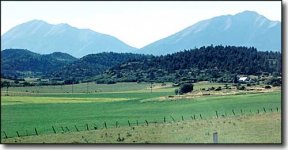Gypsy Heart
Gold Member
The Doll Rock Gold......Aguilar,Colorado
Aguilar was first named San Antonio Plaza and the Jules-Denver stage line made a stop just east of the houses. When incorporated in 1894, the town was renamed Aguilar, after Jose Ramon Aguilar who had served as a stae representative and county commissioner. The opening and closing of the area's coal mines, the Great Depression, the post World War II boom, and the exodus to the cities for jobs - all have contributed to the rise and fall of Aguilar's population, but never to its demise, earning it the name: "the town that refused to die."
The Apishapa Valley was first inhabited by ancient Native American tribes but was most recently Arapaho country. "Apishapa" is a Native word meaning "stinking water," for "the river that sometimes stands stagnant."
Tales of gold brought prospectors in the early 1800's. One group of Spaniards settled in the foothills and soon found a very rich gold mine. While they were mining, the group's leader fell in love with the local Arapaho chief's daughter. The chief approved and the Spaniard and Arapaho Princess married and had a daughter.
Later on, when they were carrying the gold back to Mexico, the Utes attacked the Spaniards. The Spaniards knew they had no chance of escape carrying that heavy gold so they buried it 300 feet from a large rock the Arapaho had named Muneca (the doll), since it resembled a 30-foot doll. In the battle that followed, only the Spaniard leader and two others escaped.
After ten years, the leader returned to the Apishapa Valley and learned that his daughter still lived but his wife had died. He did not reopen the mine. Years later, as he lay dying, he told his princess daughter of the treasure, estimated to be between one and two million dollars worth of gold. When the daughter grew old, she told her children of the gold that was buried near the Muneca at a place marked with a shovel. She forbade them to touch it until she had died.
After she died, the children searched for the gold and found the Muneca, but not the shovel. To this day, the Lost Arapaho Princess Treasure has not been found.
Aguilar was first named San Antonio Plaza and the Jules-Denver stage line made a stop just east of the houses. When incorporated in 1894, the town was renamed Aguilar, after Jose Ramon Aguilar who had served as a stae representative and county commissioner. The opening and closing of the area's coal mines, the Great Depression, the post World War II boom, and the exodus to the cities for jobs - all have contributed to the rise and fall of Aguilar's population, but never to its demise, earning it the name: "the town that refused to die."
The Apishapa Valley was first inhabited by ancient Native American tribes but was most recently Arapaho country. "Apishapa" is a Native word meaning "stinking water," for "the river that sometimes stands stagnant."
Tales of gold brought prospectors in the early 1800's. One group of Spaniards settled in the foothills and soon found a very rich gold mine. While they were mining, the group's leader fell in love with the local Arapaho chief's daughter. The chief approved and the Spaniard and Arapaho Princess married and had a daughter.
Later on, when they were carrying the gold back to Mexico, the Utes attacked the Spaniards. The Spaniards knew they had no chance of escape carrying that heavy gold so they buried it 300 feet from a large rock the Arapaho had named Muneca (the doll), since it resembled a 30-foot doll. In the battle that followed, only the Spaniard leader and two others escaped.
After ten years, the leader returned to the Apishapa Valley and learned that his daughter still lived but his wife had died. He did not reopen the mine. Years later, as he lay dying, he told his princess daughter of the treasure, estimated to be between one and two million dollars worth of gold. When the daughter grew old, she told her children of the gold that was buried near the Muneca at a place marked with a shovel. She forbade them to touch it until she had died.
After she died, the children searched for the gold and found the Muneca, but not the shovel. To this day, the Lost Arapaho Princess Treasure has not been found.




